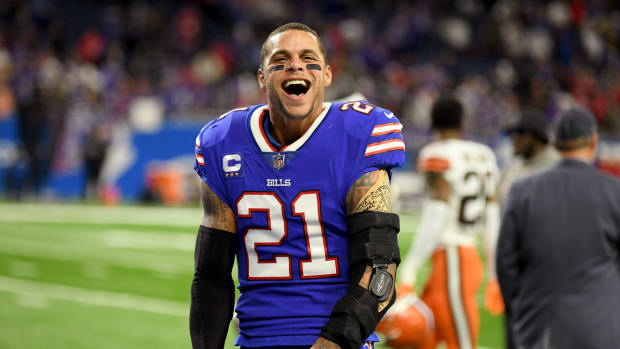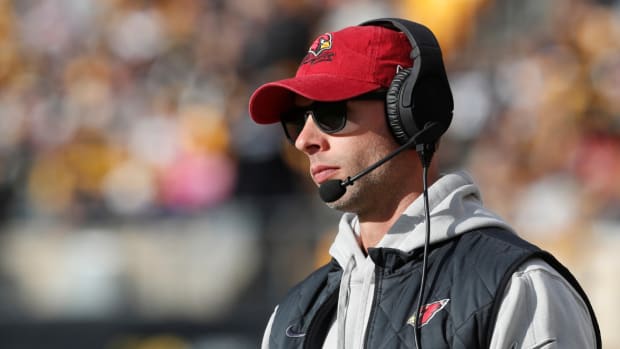NFL Wild-Card Weekend Deep Dive
New York Giants at Green Bay
Packers Offense vs. Giants Defense
When these teams met on Sunday Night in Week 5, the Giants got great play from their corners—particularly Janoris Jenkins – and almost nothing from their four-man rush. That would turn out to be the case throughout the season, which is why defensive coordinator Steve Spagnuolo has installed expansive passing-down blitz packages. Having corners he trusts on an island has put all blitz designs in play.
Against Aaron Rodgers, many teams eschew blitzing and put extra bodies in coverage. The Giants did this in that first matchup, blitzing only four times. Their thinking is Rodgers will extend the play regardless of how many rushers there are. So you might as well keep defenders in coverage.
But we may not see this approach again from the Giants. In critical moments, Spagnuolo tends to get more aggressive. Many of his blitzes involve defensive backs. They destroyed Washington with these last week, in fact. That’s noteworthy because when you play Washington, the man you must take away is tight end Jordan Reed. With the Packers, many believe the key is stopping Jordy Nelson. But the Giants should be confident in Jenkins covering Nelson outside and Rodgers-Cromartie defending him in the slot. Really, the Packers’ troubling weapon is their tight end, Jared Cook. He provides great schematic diversity, lining up all over the formation. The Packers are 8-2 when he’s been in the lineup.
The guy who usually guards tight ends for New York is Landon Collins. But this is the second-year stud’s weakness. Collins is strongest as a downhill defender, particularly on those third-level blitzes. If Spagnuolo last week blitzed Collins against an offense that boasts a tight end like Reed, he should be willing to do the same against one that has Cook.
Giants Offense vs. Packers Defense
In the Week 5 matchup, the Packers kept two safeties over the top all night to help their corners. They’ll have to do the same on Sunday. Ladarius Gunter, an undrafted player with limited raw talent but refined technique, has developed into a sturdy starter, but Damarious Randall and Quinten Rollins remain up and down on the left side, and both are questionable due to injury (Randall due to a knee injury, Rollins to a neck injury and concussion protocol). If neither can go, the Packers will likely call on Micah Hyde to play outside and hope that safety Morgan Burnett can survive in the slot. Burnett did that in Week 1 at Jacksonville and Week 17 at Detroit, but in those games he didn’t face a receiver with Sterling Shepard’s quickness and speed.
The good news for Green Bay is Giants head coach Ben McAdoo was on the Packers staff for eight years and runs a scheme that this defense is familiar with. The Packers know McAdoo’s system encourages Eli Manning to get the ball out quickly. That makes blitzing Manning pointless, which means there’s little cost to keeping both safeties back in help coverage.
* * *
* * *
Miami at Pittsburgh
Dolphins Offense vs. Steelers Defense
When these teams met back in mid-October, Jay Ajayi had the first of his three 200-yard rushing days on the season, thanks in part to Mike Pouncey’s second-level block on a perfectly executed outside zone run that sprung him for 62 yards. The run helped seal a Dolphins victory, the first of nine they’d have over the season’s final 11 games. Ajayi’s run wasn’t the only highlight; Ryan Tannehill also made his best throw of the year—a 53-yarder to tight end MarQueis Gray off improvised movement to the left.
Of course, Tannehill, still recovering from a mid-December knee injury, won’t play this Sunday. (Neither will Pouncey, on injured reserve with a hip injury.) Ten-year veteran Matt Moore has been fine filling in, though one concern is his proclivity for taking unnecessary chances downfield. And the Steelers are a defense equipped to make you pay for that. Though they haven’t done it as much as expected this season, they’re dangerous with disguised two-high safety coverage rotations behind edge blitzes. They especially do it against teams that employ dangerous slot receivers, which Miami has in Jarvis Landry. The better the tenacious Ajayi and this Dolphins O-line executes in the zone run game, the easier it will be for Adam Gase to call plays that help keep Moore away from high-risk throws.
Steelers Offense vs. Dolphins Defense
Against Miami in Week 6, Ben Roethlisberger threw two interceptions in what was one of his weaker performances on the season. One was to Reshad Jones, the other to Isa Abdul-Quddus. Both safeties are now on I.R. Their replacements, Michael Thomas and Bacarri Rambo (battling a chest injury himself) are not liabilities in Miami’s relatively safe zone scheme, but they’re certainly the guys Pittsburgh wants to attack.
The way to attack zone safeties is with vertical routes inside. Think slot receivers and tight ends. The temptation might be to use Antonio Brown here. But for much of this season, Brown has played alone on the weak side. This makes it harder for defenses to disguise their double-teams on him. Miami’s outside corners Tony Lippett and Byron Maxwell (or rookie Xavien Howard, if Maxwell’s injured ankle still isn’t healed) have been mostly stellar, but expect D coordinator Vance Joseph to still roll a safety over the top against No. 84. With the coverage now defined on Brown’s side, a keen veteran like Roethlisberger will have little trouble isolating the safety on the other side.
* * *
Detroit at Seattle
Lions Offense vs. Seahawks Defense
This season the Seahawks played more man coverage in critical passing situations. We could see this continue Saturday given how exposed the Seahawks were in Cover 3 early last week against the 49ers. There was some question as to whether defensive coordinator Kris Richard would keep calling man-to-man after Earl Thomas went down in December. In Seattle’s man coverages, Thomas was often the robber, patrolling the shallow middle of the field, or he was assigned to the opponent’s fourth most threatening receiver.
In the first game after Thomas went down for the season, Week 14 at Green Bay, Richard mostly stayed away from man coverage even though that’s been the league-wide preferred tactic against the Packers. In the following two weeks however, against division rivals Los Angeles and Arizona, the man-to-man returned. Richard would be wise to go there again for two reasons: (1) The Lions receivers aren’t dynamic enough to separate from physical press artists like Richard Sherman, DeShawn Shead and Jeremy Lane. And (2) Thomas’s replacement, Steven Terrell, has given up a number of big plays, both before and after the catch, by aligning too flat and taking poor angles. The Lions will have a much easier time isolating Terrell in zone than in man.
Seahawks Offense vs. Lions Defense
You never quite know what you’re going to get from Seattle’s offense. That’s how it goes with a week-to-week O-line and a quarterback of Russell Wilson’s unique style. Though Wilson’s sandlot playmaking is hard to match, this offense is most difficult to defend when it’s operating crisply on-schedule. The two guys who give the offense dimension here are Doug Baldwin, one of the best short-area receiving weapons in football, and Jimmy Graham, one of the best seam-area threats. But how will these two look now that there’s no speedy Tyler Lockett to threaten defenses over the top?
The Lions play a lot of two-high coverages. If they’re not threatened downfield, safeties Glover Quin and Tavon Wilson can be aggressive. This impacts not just Baldwin and Graham, but also how the Lions react to Russell Wilson’s scrambles and read-option looks. The more critical the moment, the likelier it is Wilson will use his legs. Quin and Tavon Wilson will be big factors in how that goes.
* * *
Oakland at Houston
Raiders Offense vs. Texans Defense
As expected, the Raiders kept things basic for Connor Cook at Denver last week. Cook was most comfortable throwing underneath. Offensive coordinator Bill Musgrave had much of the passing game take place out of 2x2 formations. That created either/or reads for Cook on both sides of the field. Don’t be surprised to see more of this Saturday afternoon. The Texans have been more aggressive with coverage disguises as the season has gone on. Their foundation remains Quarters, with four defensive backs playing the back end. Musgrave is great at creating one or two deep-shot plays to attack predicted zone coverage. He’ll have to be selective here, however, because Quarters is easy to rotate out of. Any deep shots the Raiders call must have both the deep target and checkdown located outside the field numbers, not over the middle. The better the Raiders run the ball, the easier it is to get to the shot plays. Oakland’s vaunted O-line must bounce back from last week’s underwhelming performance and reestablish its powerful inside zone game. As the Raiders learned in the first meeting, when they gained only 30 yards on 20 rushes, the Texans aren’t an easy front seven to do that against.
Texans Offense vs. Raiders Defense
When Brock Osweiler is uncomfortable he plays very mechanically, both physically and mentally. At times, he can even play robotically. This has made him prone to throwing late and/or into coverage. There are two ways to approach this defensively, of which both the Raiders are capable. One is to play zone so that defenders can have eyes on Osweiler and pounce when his mistakes occur. The other is to play man-to-man and hope to incite Osweiler into robotic play by shrinking his throwing windows. Unless the game situation demands it, Osweiler has not been comfortable attacking tight windows. (That’s a big reason why he and DeAndre Hopkins haven’t jibed. Hopkins is a contested catch artist, not a separator. He demands tough throws.) When the Raiders saw Osweiler in Mexico City earlier this year, they opted for the man coverage. In fact, they doubled-down on it, keeping both safeties back, often over the top but sometimes with one in a robber position over the middle. From this, they rushed four. There’s no reason to think we won’t see the same formula again, especially given that Houston’s struggling O-line doesn’t have a right tackle who can handle Khalil Mack or Bruce Irvin one-on-one.
Question or comment? Email us at talkback@themmqb.com.




































